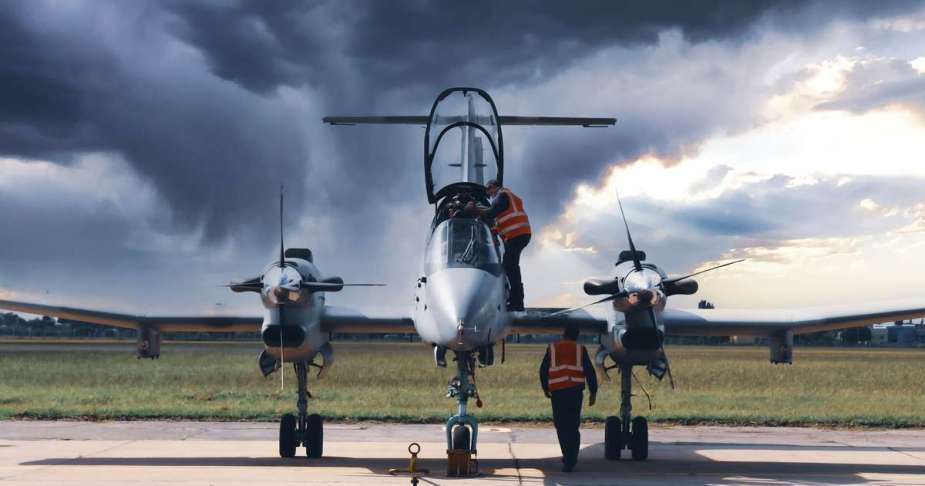The IA-58 Pucará's engine replacement program, now known as the Pucará Fénix, has reached a pivotal milestone with the achievement of its remotorization certification from Argentina's Joint Military Aeronautical Airworthiness Directorate (Digamc). This certification, awarded to the Argentine Aircraft Factory (FAdeA), signifies the commencement of the series aircraft's update.
Follow Air Recognition on Google News at this link
 The Argentinian IA-58 Pucarás will benefit from an engine replacement program (Picture source: FAdeA)
The Argentinian IA-58 Pucarás will benefit from an engine replacement program (Picture source: FAdeA)
This evolution is the result of a collaboration between FAdeA, the Argentine Air Force (FAA), Digamc, and international partners such as Pratt & Whitney Canada P&WC, Hartzell, and IAl. The joint effort bore fruit after over 150 hours of flight testing and 109 test flights, leading to the equipping of each aircraft with two Pratt & Whitney PT6A-62 turboprop engines and Hartzell four-blade propellers.
The Pucará Fénix, formerly a ground-attack aircraft, is now intended for ISR (Intelligence, Surveillance, and Reconnaissance) missions. This shift towards modern surveillance functions contrasts with the attack role of the rest of the Pucará fleet.
The project includes a complete modernization of the cockpit and avionics systems, the addition of air conditioning systems, and the removal of obsolete components. The Pucará Fénix thus becomes the platform for the progressive development of the ISR POD, with enhancements such as AESA active antenna radars and EO/IR sensors envisioned in future configurations.
The remotorization certification of the Pucará Fénix represents a significant advancement in modernizing Argentina's aerial arsenal. By pivoting towards ISR capabilities, Argentina is adapting its military equipment to the current demands of defense and surveillance operations.
The development of the IA-58 Pucará, initiated in August 1966 by the Argentine Air Force (FAA), aimed to create an aircraft suitable for close air support (CAS) and counter-insurgency (COIN) missions. The first prototype, named AX-2 Delfin, equipped with 904 hp Garrett TPE331I/U-303 engines, made its maiden flight on August 20, 1969. "Pucará", meaning fortress in the Quechua language, was later fitted with French Turbomeca Astazou XVI G engines in other prototypes.
Constructed entirely of metal, the IA-58 is designed to operate in light guerrilla conditions, with an armored cockpit and windshield and landing gear suited for unprepared runways. It is notable for its ability to take off in just 80 meters using JATO rockets and is designed for simple maintenance. This two-seater is equipped with Martin-Baker Mk 6AP6A zero/zero ejector seats.
The serial version IA-58A, or Pucara Alpha, first flew on November 8, 1974, and was delivered in 1975 to the III Air Brigade, with 108 units built until 1986. The IA-58B, or Pucara Bravo, featured 30 mm DEFA 553 cannons and improved avionics but was built in only one example. Similarly, the IA-58C (Pucara Charlie), a single-seat version with a HUD, IFF, and additional hardpoints, was built in only one example. Finally, the IA-66, equipped with more powerful Garrett engines, was also produced in a single example.
The IA-58 Pucarás were deployed by Argentina during the Falklands War, where, despite their numbers, they were unsuited against an adversary like the British, suffering heavy losses mainly on the ground. They did, however, manage to shoot down a Westland Scout. After the conflict, 11 aircraft were captured by the British, including 4 in flying condition, and 6 are now displayed in museums.
With the emergence of more advanced technologies and the evolution of military requirements, the Pucará began to show signs of obsolescence, particularly in its engines and avionics systems. In response to these challenges, the Pucará Fénix project was launched, aiming to modernize the aircraft through remotorization with Pratt & Whitney PT6A-62 turboprop engines and the update of avionics systems and propellers. This renewal has also led to a significant shift in the aircraft's role, transforming it from a ground attack aircraft to an ISR (Intelligence, Surveillance, and Reconnaissance) platform, suited to contemporary needs for reconnaissance and surveillance. The Pucará Fénix is now envisioned as an evolutionary platform, capable of progressively integrating cutting-edge technologies such as AESA active antenna radars and EO/IR sensors, thus marking its transition to a more sophisticated and strategic role in the Argentine military.
















